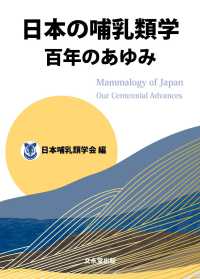- ホーム
- > 洋書
- > ドイツ書
- > Humanities, Arts & Music
- > Literary Studies
Full Description
This book shows the literary legacy of Bolesław Leśmian, the great Polish writer, as engaged in a dialogue with the tradition, and forged on the crossroads of literatures, and epochs. Exploring American, French and Russian contexts (Poe's writing, Baudelaire's oeuvre, Balmont's texts, the symbolist style, the bylinna tradition), highlighting the correspondences between Leśmian and the romantics (Pushkin, Gogol) as well as the modernists (Jesienin, Gorodetsky) and connecting his work to Ukrainian culture through the evocation of old Slavic folklore, the book showcases Leśmian's work as an example of interliterary and inter-cultural transfer of aesthetics, styles, genres and motifs. A crucial outcome of this research is the codifying of a contextual analysis as a method of comparative studies.
Contents
Contents
I INTRODUCTION .................................................................................. 10
II CONTEXT AND METHOD .............................................................. 25
PROBLEMS OF CONTEXTS AND RESEARCH METHODS IN
COMPARATIVE STUDIES ......................................................................... 27
The subject of comparative studies ........................................................... 27
Typology of contexts ................................................................................... 29
Contextual analysis as a method of historical comparative studies ..... 34
Contextual comparative analysis of literary texts against the issue
of historicity ................................................................................................. 39
Aims of contextual comparative analysis ................................................. 41
III CONTEXT RELATIONS: LEŚMIAN COUNTERPOSED
WITH LITERARY PREDECESSORS AND CULTURAL
TRADITIONS .......................................................................................... 45
I CROSS-LITERARY FILIATIONS ............................................................. 46
Literary Mediations (Poe - Baudelaire - Balmont - Leśmian) ............. 48
Poe via the symbolists: searching for sources of Leśmian's
inspirations ........................................................................................... 48
Baudelaire's Poe .................................................................................... 51
Balmont's Poe ....................................................................................... 57
Translative replicas (Poe - Baudelaire - Leśmian) ................................. 64
Poe's tales in Bolesław Leśmian's translations: sources,
inspirations, replicas ............................................................................ 64
Poe versus Leśmian: outlining the problem ................................ 64
Leśmian and translators: the Genesis of Fascination
with Poe ........................................................................................... 65
Poe translated by Leśmian from Baudelaire ............................... 73
Aesthetic transformations (the aesthetics of death: Poe
- Baudelaire - Balmont - Leśmian) ......................................................... 86
Ways of representing death ................................................................ 86
Aestheticizing death ............................................................................ 86
De-specification and/or alegorization of death ............................... 98
Macabre aesthetics ............................................................................. 106
Macabresque aesthetics ..................................................................... 115
Stylistic and structural influences (symbolist style - the bylina
tradition - the early prose work of Leśmian) ........................................ 130
The Symbolist Style of Bolesław Leśmian's Early Work
(illustrated by the case of "Baśń o Rycerzu Pańskim"
["Tale of the Lord's Knight"]) ........................................................... 130
The lexical layer ............................................................................ 131
The structural layer ...................................................................... 134
Creative Inspirations or Influences? .......................................... 144
II THE INTERCULTURAL HOMOLOGIES .......................................... 146
The structural reminiscences (demonic female
characters: Pushkin - Gogol - Leśmian) ............................................... 148
Not just folklore: on neglected intercultural homologies ............. 148
The function of female demons in Romantic literature, and
their transformations in Leśmian's works ...................................... 152
The anticipation of death: the horror of self-knowledge ........ 152
The victims and/or avengers: the hell of memory .................... 154
Initiation into the experience of time: the hell of nature ............. 157
The grotesque figure of the witch: from Pushkin to Gogol
and Leśmian .................................................................................. 157
The Gogol context in Leśmian's "The Witch" ........................... 160
Grotesque embarrassment .......................................................... 163
Grotesque reconstruction of the stereotype of femininity ........... 165
Grotesque disillusion and social roles ............................................ 170
Metaphorical and parodistic-apocryphal transformations (forms
of kaliki perekhozhie: Yesenin - Gorodetsky - Leśmian) ..................... 175
Common cultural traditions? .......................................................... 175
The three poets' kaliki as protagonist or collective subject .......... 178
Kaliki of Gorodetsky and Leśmian as parodist and individual
characters ............................................................................................ 184
The protagonist on the road ............................................................. 199
Pilgrimaging kaliki-kaleki? .............................................................. 206
Homologies or filiations? .................................................................. 208
Genre and structural modifications, thematic references, lexical
repetitions (Leśmian's poetry and Ukrainian culture and folklore) ... 211
Ukrainian culture and folklore in Leśmian's poetry? .................... 211
Generic and structural modifications ............................................. 213
Thematic references ........................................................................... 222
Lexical repetitions ............................................................................. 226
How many traditions and cultures? ................................................ 229
IV LITERARY FOLLOWERS OF LEŚMIAN'S POETIC ............. 235
FROM ALLUSION TO LITERARY STYLIZATION: LEŚMIAN'S
INTERTEXT IN CONTEMPORARY POLISH POETRY ..................... 237
Leśmian: Poet with No Followers? .......................................................... 237
Parodist and pastiche stylizations ........................................................... 241
Continuations of Leśmian's aesthetics of death ..................................... 247
Continuations of Leśmian's erotics ......................................................... 252
IMITATORS? FOLLOWERS? SUCCESSORS? ....................................... 255
V CONCLUSION ......................................................................................... 257
BIBLIOGRAPHIC NOTE ........................................................................... 277
BIBLIOGRAPHY ............................................................................................ 281
INDEX ................................................................................................................. 331







